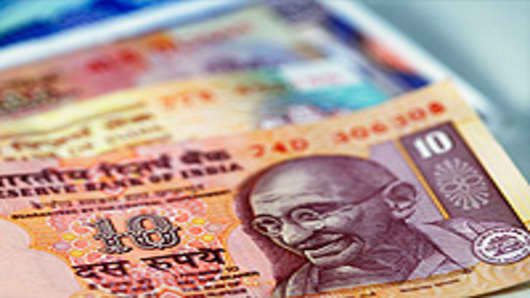India announced a number of measures on Monday to support the embattled rupee, including raising the limit on foreign investment in government bonds, but analysts told CNBC the moves will not reverse the downtrend in the currency, which has declined over 25 percent in the last 12 months.
The Reserve Bank of India (RBI) increased the limit on foreign investment in government bonds by $5 billion to $20 billion, along with a slew of smaller measures such as a reduction in the lock-in period on investments in infrastructure and the opening of investment in debt securities to more types of foreign buyers.
The rupee ,and benchmark Sensex, which had rallied earlier in the day on expectations of more aggressive measures, trimmed gains following the announcement by the central bank.
“It may help the rupee in the short-term, but in the large scheme $5 billion isn’t enough to counter balance the sentiment or the factors that have contributed to the slide of the rupee. The government will have to do a lot more,” Anita Yadav, Managing Director at corporate bond brokerage and asset management firm SJ Seymour Group told CNBC.
The rupee, one of Asia’s worst performing currencies, has been driven lower by a combination of deteriorating global risk sentiment and weak domestic fundamentals, including slowing growth and large current account and budget deficits.
Taimur Baig, Director & Chief Economist, Global Markets Research, Deutsche Bank agrees that the steps taken on Monday failed to address wider concerns weighing on the currency.
“The fact of the matter is that the rupee has been under pressure due to a combination of worsening trade balances and anemic capital inflows. There is only so much administrative measures can do to alter these fundamental driven dynamics,” Baig said.
“Today's measures are just a part of the large number of steps taken by the authorities over the past six months, ranging from further liberalization of the capital account to attract flows to administrative measures to prevent speculation,” he added.
In order for the rupee to see sustained gains, Robert Prior-Wandesforde, Asia Economics Director at Credit Suisse, says the government would need to announce measures which reduce the current account deficit and attract foreign investment.
“These kinds of measures are not going to turn the currency around, for that we need a bigger positive surprise like an increase in subsided fuel prices, concrete action for multi-brand retailers, none of that has happened,” he said.
By CNBC's Ansuya Harjani



